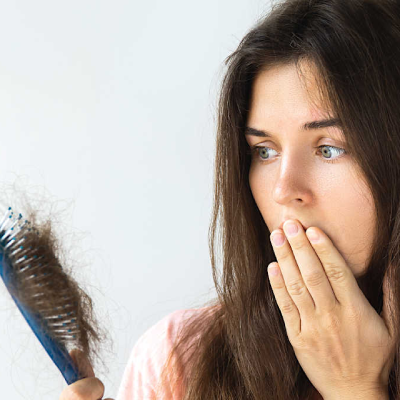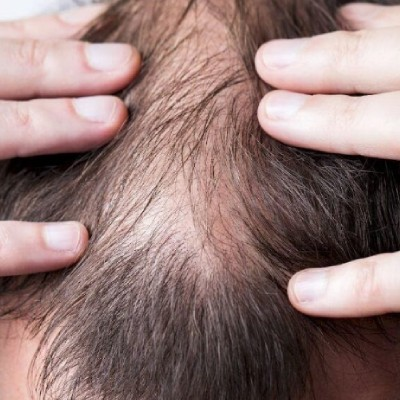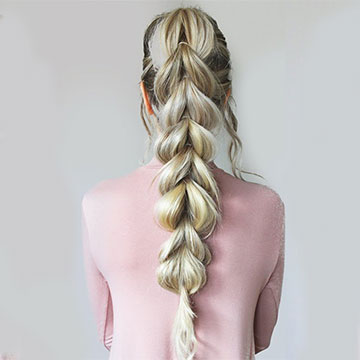Tight Ponytails - Are They to Be Blamed for Hair Loss?

15 October 2019

Hair Experts @ AHS

Not all types of hair loss are caused by genetic factors, hormonal changes, or environmental pollution. How we tie our hair and take care of it is equally responsible for its health.
Not all types of hair loss are caused by genetic factors, hormonal changes, or environmental pollution. How we tie our hair and take care of it is equally responsible for its health.
People who tie their hair in a tight bun or a ponytail often complain of a condition called Traction Alopecia — hair loss that is caused by the repeated pulling of hair follicles at their roots. You can develop this if you have a habit of tightly pulling your hair into a neat bun.
However, people who use chemical straighteners and heat-generating styling products, such as rollers, etc., have a greater tendency to suffer from this medical condition. This is because these products make the hair strands even weaker.
This blog looks at the problems that may arise due to wearing tight ponytails and what can be done about it.
What is Ponytail?
A ponytail is a hairstyle commonly used by women (sometimes even men) of all ages. The hairstyle is so common that hairstylists sometimes refuse to categorize it as a style altogether, preferring to call it a part of the daily routine.
In a ponytail, women usually gather up all the hair strands together and tie them at the back of the head in a way that the hair neatly falls in one piece. A ponytail is perhaps the simplest style followed by women. It requires no special styling equipment, except for a hair clip or a hair tie.

A variant of this style is the pigtail, which is usually preferred by younger girls. This is a smaller variant of the ponytail. The history of this style is also equally fascinating. From Greek and Roman frescoes, we come to know that this style was popular in antiquity, but got somewhat lost in the Middle and Victorian Ages when women started preferring more elaborate styles.
Interestingly, in the modern ages, the style was revived by the first Barbie Doll by Mattel, which popularized the style among young girls and was quickly followed by older women. The style was also preferred by men in the second half of the 18th century.
Men of the courts used to gather their hair in a neat tail and wrap it around with a silk bag. Similarly, the style was immensely popular among the Chinese during the Qing dynasty. Finally, during the 1970s, the style once again picked up popularity with rock-and-roll musicians sporting ponytails.
Recently, however, tight ponytails have come under the scanner because of a range of medical issues they might lead to. If timely intervention is not done, the hair damage can become permanent and lead to hair loss.
How Tight Ponytails Affect Hair Loss?
Tight ponytails have been associated with a range of medical complications, including headaches and hair loss because of the repeated hair pulling that occurs due to this style. Recently, for example, singer Ariana Grande complained of a splitting headache because of this hairstyle, which she wore for long hours during a concert.

Ponytails, by themselves, are not necessarily harmful to the hair. The hair shaft or the hair follicles do not have nerve cells to feel the pain. However, the areas of the scalp in which the hair follicles are embedded are extremely sensitive and prone to pain.
Repeated pulling can damage the roots of the hair leading to hair damage. This, when left untreated, can lead to hair loss in the long run.
Steps to prevent hair loss
There are a few simple steps in preventing ponytail induced hair loss. These include:
- Avoid wearing tight ponytails and pigtails.
- Try to wear hairstyles that are easy and comfortable in nature.
- You can also wear thick braids instead of finer ones.
- Finally, choose fabric hair ties instead of plastic or leather hair ties.
Do Ponytails Cause Traction Alopecia?
Traction Alopecia is a particular kind of hair loss that is caused by repeatedly pulling at one’s own hair. This can occur particularly to those individuals, who wear their hair in a tight bun, braid or ponytail. Traction Alopecia can be reversed if care is taken early.

However, the hair damage can become permanent if you do not take care soon enough. The condition was noticed by doctors in Greenland first in the early 1900s.
How Is It Different From Alopecia Areata?
In order to understand Traction Alopecia better, it is important that we distinguish it from other kinds of alopecia, like Alopecia Areata. In Alopecia Areata, there is patchy hair loss throughout the scalp.
Sometimes these bald patches can grow bigger, thereby covering the whole scalp. This is called Alopecia Totalis. In some rare cases, Alopecia can spread to the whole body, affecting the hair follicles all over the body. This is known as Alopecia Universalis.
Furthermore, Alopecia Areata is mainly genetic in nature (although stress may be a factor), whereas Traction Alopecia is mainly a result of our hairstyle. Traction Alopecia may involve a range of other symptoms, including hair loss, redness of the scalp, soreness, bumps, itching, scaling, folliculitis, and pus-filled blisters. If left untreated, the hair follicles may become so damaged that they cannot be repaired.
How Long Does It Take for Hair to Grow Back After Traction Alopecia?
Traction alopecia can be effectively treated. However, timely intervention is necessary in order to help hair to grow back.
- Firstly, if you are suffering from the initial stages of Traction Alopecia, then simply changing your hairstyles would be enough. No separate treatment is required. Once you start wearing your hair loose, then you will soon see a difference in your condition.
- Secondly, Traction Alopecia can also be aggravated due to the use of chemicals and heat. As such, if your hair routine involves the use of chemicals and heat styling products, like rollers and straighteners, then you should avoid these for a while to see the difference.
- Thirdly, doctors might also suggest some of the following medications for the treatment of extreme cases of Traction Alopecia. These include:
- Antibiotics to prevent infection on the open sores on the scalp
- Topical steroids in powder form
- Antifungal shampoos
- Over-the-counter drugs such as Minoxidil
- Biotin shampoos in order to promote hair growth.
Conclusion
Traction Alopecia is a kind of hair loss found in many women, who tie their hair in tight ponytails. It, however, is preventable and can be avoided by wearing hairstyles that are easy on the hair.
If you are worried about hair loss from wearing ponytails, then book an appointment with one of our hair experts. We, at Advanced Hair Studio, provide a range of cutting-edge surgical and non-surgical treatments for hair.
For the overall health of the hair and to keep hair problems like male pattern baldness and Traction Alopecia at bay, we highly recommend opting for our AHS Complete Hair Program, which not only restores your hair but also makes sure that the new hair strands are better in both texture and quality.
FAQs on Ponytail
Is It Bad to Wear Your Hair in a Ponytail Every day?
While it is not bad to wear ponytails every day, one should be careful about not wearing a tight ponytail. A tight ponytail can not only cause hair damage and hair loss, but it can also cause headaches that can be extremely uncomfortable.
It is better to tie your hair loosely in a neat bun or a ponytail that is not too tight. Also, when you are home or going to sleep, you should not ideally wear any hairstyles. Regular brushing is also required for hair regrowth.
How Do You Fix a Receding Hairline from a Ponytail?
Hair follicles can be severely damaged because of a tight ponytail. If care is not taken, it can become permanent and can lead to hair loss. However, there are common, over-the-counter medications available. One of the most effective medications is Minoxidil. Apart from medications, one can also use a variety of home-grown techniques.
Hair oils are an excellent means of growing hair. Oils such as castor oil, extra-virgin coconut oil, and almond oil are all great for hair. Finally, both diet and exercise increase the blood flow to the scalp thereby promoting hair growth. All these can help in fixing the receding hairline as a result of Traction Alopecia.
Do Ponytails Cause Hair Breakage?
Not all ponytails can cause hair breakage. Ponytails and pigtails are in fact quite common among women. However, those who have a tendency of wearing their hair in tight ponytails, pigtails, buns, etc. can suffer from hair breakage. Repeated pulling of hair strands can cause hair damage, and in extreme cases can lead to open sores, wounds and hair breakage.
How Can I Regrow Hair from Traction Alopecia?
If caught early, Traction Alopecia is fully reversible. However, if neglected, hair follicles can become irreversibly damaged to the extent that they cannot regrow. Therefore, timely intervention is essential. Next comes medications. Both over-the-counter drugs and natural home remedies are available. If there is extensive hair loss, you can also try to look for surgical and non-surgical hair transplant options.
Stay Updated
Subscribe to our email newsletter for helpful tips and valuable resourses
Be an influencer
Join forces with Advanced Hair Studio! Explore exciting collaboration opportunities tailored for influencers. Let's redefine haircare together.
Connect now












